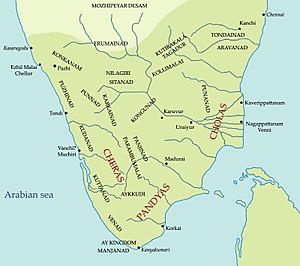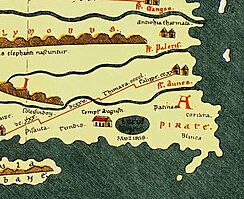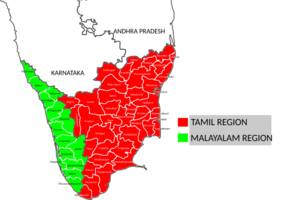Tamilakam facts for kids
Tamilakam (Tamil: தமிழகம், romanized: Tamiḻakam) was the geographical region inhabited by the ancient Tamil people, covering the southernmost region of the Indian subcontinent. Tamilakam covered today's Tamil Nadu, Kerala, Puducherry, Lakshadweep and southern parts of Andhra Pradesh and Karnataka. Traditional accounts and the Tolkāppiyam referred to these territories as a single cultural area, where Tamil was the natural language and permeated the culture of all its inhabitants. The ancient Tamil country was divided into kingdoms. The best known among them were the Cheras, Cholas, Pandyans and Pallavas. During the Sangam period, Tamil culture began to spread outside Tamilakam. Ancient Tamil settlements were also established in Sri Lanka (Sri Lankan Tamils) and the Maldives (Giravarus), prior to the migration of Prakrit speakers.
During the Prehistorical, Classical, Middle and Early Modern ages, the entire region of Tamilakam remained unconquered by the Northern Indo-Aryan dynasties, ranging from the Maurya Empire to the Mughal Empire.
In contemporary India, Tamil politicians and orators often use the name Tamilakam to refer to Tamil Nadu alone.
Contents
Etymology
"Tamiḻakam" is a portmanteau of a word and suffix from the Tamil language, namely Tamiḻ and -akam. It can be roughly translated as the "home of Tamil". According to Kamil Zvelebil, the term seems to be the most ancient term used to designate Tamil territory in the Indian subcontinent.
The Periplus of the Erythraean Sea, as well as Ptolemy's writings, mention the term "Limyrike" which corresponds to the Malabar Coast of south-western India. The Roman map Tabula Peutingeriana includes a place named "Damirica" (or "Damirice") and because this sounds like "Tamil," some modern scholars have equated it with Limyrike, considering both to be synonyms of "Tamilakam". However, the "Damirice" mentioned in the Tabula Peutingeriana actually refers to an area between the Himalayas and the Ganges.
Extent
The term "Tamilakam" appears to be the most ancient term used for designating the Tamil territory. The earliest sources to mention it include Purananuru 168.18 and Patiṟṟuppattu Patikam 2.5. The Specific Preface (cirappuppayiram) of the more ancient text Tolkāppiyam mentions the terms tamil-kuru nal-lulakam ("the beautiful world [where] Tamil is spoken") and centamil ... nilam ("the territory ... of refined Tamil"). However, this preface, which is of uncertain date, is definitely a later addition to the original Tolkāppiyam. According to the Tolkāppiyam preface, "the virtuous land in which Tamil is spoken as the mother tongue lies between the northern Venkata hill and the southern Kumari."
The Silappadikaram (c. 2nd century CE) defines the Tamilakam as follows:
The Tamil region extends from the hills of Vishnu [Tirupati] in the north to the oceans at the cape in the south. In this region of cool waters were the four great cities of: Madurai with its towers; Uraiyur which was famous; tumultuous Kanchi; and Puhar with the roaring waters [of the Kaveri and the ocean].
While these ancient texts do not clearly define the eastern and western boundaries of the Tamilakam, scholars assume that these boundaries were the seas, which may explain their omission from the ancient definition. The ancient Tamilakam thus included the present-day Kerala. However, it excluded the present-day Tamil-inhabited territory in the North-East of Sri Lanka.
Subdivisions
Kingdoms
From around 600 BCE to 300 CE, Tamiḻakam was ruled by the three Tamil dynasties: the Chola dynasty, the Pandyan dynasty and the Chera dynasty. There were also a few independent chieftains, the Velirs (Satyaputra). The earliest datable references to the Tamil kingdoms are in inscriptions from the 3rd century BCE during the time of the Maurya Empire.
The Chola dynasty ruled from before the Sangam period (~3rd century BCE) until the 13th century in central Tamil Nadu. The heartland of the Cholas was the fertile valley of the Kaveri. The Pandyan dynasty ruled parts of South India until the late 17th century. The heartland of the Pandyas was the fertile valley of the Vaigai River. They initially ruled their country from Korkai, a seaport on the southernmost tip of the Indian Peninsula, and in later times moved to Madurai. The Chera dynasty ruled from before the Sangam period (~3rd century) until the 12th century over an area corresponding to modern-day western Tamil Nadu and Kerala.
The Vealirs (Vēḷir) were minor dynastic kings and aristocratic chieftains in Tamiḻakam in the early historic period of South India.
Nations of Tamilakam
Tamiḻakam was divided into political regions called Perunadu or "Great country" ("nadu" means country).
There were three important political regions which were Chera Nadu, Chola Nadu and Pandya Nadu. Alongside these three, there were two more political regions of Athiyaman Nadu (Sathyaputha) and Thamirabharani Nadu (Then Paandi) which were later on absorbed into Chera and Pandya Nadu by 3rd century BCE. Tondai Nadu which was under Chola Nadu, later emerged as independent Pallava Nadu by 6th century CE.
Tamilakam was also divided into 13 socio-geographical regions called Nadu or "country", each of which had their own dialect of Tamil.
- Thenpandi Nadu
- Panri Nadu
- Kuda Nadu
- Punal Nadu
- Puzhi Nadu
- Venadu
- Aruva Nadu
- Kakkanadu
- Kuttanadu
- Aruva Vadathalai Nadu
- Sida Nadu
- Erumai Nadu
- Malai Nadu
- Tulu Nadu
Nations outside Tamilakam
Some other Nadus are also mentioned in Tamil literature which were not part of Tamilakam, but the countries traded with them in ancient times.
- Eela Nadu (Eelam)
- Naga Nadu or Yazh Kuthanadu (Jaffna Peninsula)
- Vanni Nadu (Vanni region)
Other:
- Vengi Nadu
- Chavaka Nadu (Java)
- Kadara Nadu (Kedah)
- Kalinga Nadu
- Singhala Nadu
- Vadugu Nadu
- Kannada Nadu (Land of Kannada people)
- Telunka Nadu (Land of Telugu people)
- Kolla Nadu
- Vanka Nadu
- Magadha Nadu
- Kucala Nadu
- Konkana Nadu
- Kampocha Nadu (Cambodia)
- Palantivu Nadu (Maldives)
- Kupaka Nadu
- Marattha Nadu
- Vatuka Nadu
- Tinmaitivu (Andaman and Nicobar Islands)
Geocultural unity
Although the area covered by the term "Tamilakam" was divided among multiple kingdoms, its occurrence in the ancient literature implies that the region's inhabitants shared a cultural or ethnic identity, or at least regarded themselves as distinct from their neighbours. The ancient Tamil inscriptions, ranging from 5th century BCE to 3rd century CE, are also considered as linguistic evidence for distinguishing Tamilakam from the rest of South India. The ancient non-Tamil inscriptions, such as those of the northern kings Ashoka and Kharavela, also allude to the distinct identity of the region. For example, Ashoka's inscriptions refer to the independent states lying beyond the southern boundary of his kingdom, and Kharavdela's Hathigumpha inscription refers to the destruction of a "confederacy of Tamil powers".
Interaction with Sri Lanka
During the protohistoric period (1000-500 BCE) Sri Lanka was culturally united with southern India, and shared the same megalithic burials, pottery, iron technology, farming techniques and megalithic graffiti. This cultural complex spread from southern India along with Dravidian clans such as the Velir, prior to the migration of Prakrit speakers. The Annaicoddai seal, dated to the 3rd century BCE, contains a bilingual inscription in Tamil-Brahmi. Excavations in the area of Tissamaharama in southern Sri Lanka have unearthed locally issued coins produced between the second century BCE and the second century CE, some of which carry Tamil personal names written in early Tamil letters, which suggest that Tamil merchants were present and actively involved in trade along the southern coast of Sri Lanka by the late classical period. Around 237 BCE, "two adventurers from southern India" took control of the Anuradhapura kingdom. In 145 BCE Elara, a Chola general or prince known as Ellāḷaṉ took over the throne at Anuradhapura and ruled for forty-four years. Dutugamunu, a Sinhalese, started a war against him, defeated him, and took over the throne. Tamil Kings have been dated in Sri Lanka to at least the 3rd century BCE.
Religion
Hinduism (Vaishnavism, Kaumaram, Shaktism, Shaivism,), Dravidian folk religion, Jains and Buddhists have coexisted in Tamil country since at least the second century BCE.
Economy
Agriculture
Industry
See also
- Sources of ancient Tamil history
- Chronology of Tamil history
- History of Tamil Nadu
- History of Kerala
Sources
Printed sources





